 |
| Becky at Furano Dake |
Some skiers and snowboarders claim that Hokkaido in Japan has some of the best quality snow on Earth in terms of lightness and abundance. The explanation is that very cold and huge snow storms from Siberia travel over the Sea of Japan and dump a ton of beautifully light powder on Hokkaido. The Niseko area gets roughly 16 meters (53 feet) of snow each winter. This pattern repeats fairly reliably every year, which makes the island a very desirable ski destination.
After several years of drooling over photos and videos, Laure, Peter and I decided to finally pull the trigger and book a guided backcountry tour. During the preparation period, we found out that Laure had something baking in the oven, which forced her to cancel this part of our Japan trip. Since she loves me so much, she gave me the green light to go without her provided that one day we'd go back there again together.
Peter and I did our ski touring trip with
Hokkaido Powder Guides, which was highly recommended albeit relatively more expensive compared to other guiding companies. We chose the "Hokkaido's 3 Volcanoes" tour with seven days of ski touring in primarily two regions: the Niseko area and the Daisetsuzan National Park. The tour also had an extra three days to travel and relax in the beginning, middle, and end of the trip.
 |
| The two primary regions where we skied. |
Day 0: Arrival at Annupuri in the Niseko area
After checking out the
Snow Festival in Sapporo, Peter and I said our goodbyes to Laure before boarding on a shuttle to Annupuri, where we set as a home base for the first half of the trip.
 |
| The Sekka lodge was our home base in the Niseko area. |
Skiers and snowboarders typically stay at hotels for these types of multi-day ski touring trips in Japan. They unfortunately don't have some of the nice mountain huts like the ones you find in the Alps and the weather is too damn cold to allow snow camping. The advantage is that our backpacks were usually very light and we got to enjoy the comfort of proper showers, beds, and pretty good restaurants. The main disadvantage is that each ski day started and ended with a (sometimes longish) car ride to and from the trailhead, which is not nearly as nice as skiing out the door.
After settling into our lodge, Peter and I took the local bus to check out the main city Niseko.
 |
| Taiko drummers in Niseko. |
As soon as we walked into a ski shop to get my splitboard tuned, I felt like we were teleported to Australia. I had read that Niseko is a major ski destination for Australians, but it was still surprising to see and hear so many of them.
Niseko seems to be a pretty cool town especially for those looking to party at night and go resort skiing during the day. On the other hand, it's not the right place for those that want to get a taste of Japanese culture. In hindsight, the smaller nearby town Annupuri worked better for us since we were waking up early to go ski touring and preferred a more laid back atmosphere.
The group
At night, we met others from our group and our guide Yoshiko to discuss our plans and weather conditions. Yoshiko was born and raised in Japan; and now she lives in Reno and skis in Tahoe. We were excited to have her as our guide because she was highly recommended by our friend Fernando.
We also met a couple from Salt Lake named Cameron and Becky, who had arrived a few days earlier. They were staying in the same lodge as us, so we got to spend some time getting to know them early on.
Next morning, we met the other two in our group: Chris and Charles. They are good friends from school in the US and nowadays Charles lives in the UK and Chris lives in Vermont.
I was surprised that everyone in our group (at some point) lived in the US, whereas I had expected a mix of Japanese, Europeans, and Australians. Additionally, everyone was a skier except for me, which initially made me feel somewhat self-conscious. But frankly, I was so excited that I brushed aside all feelings of queasiness.
Day 1: Chisenupuri near Niseko
On our first day skiing, we went to a nearby mountain called Chisenupuri. Although there had been a warm spell during the preceding days, a cold storm had kicked in just as we arrived. Score.
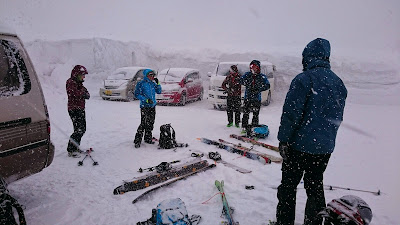 |
| We started with some basic avalanche rescue drills at the trailhead. |
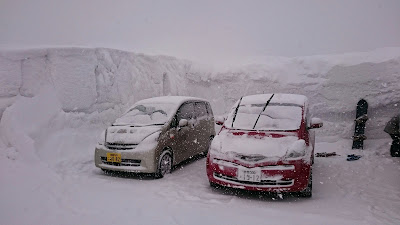 |
| Impressive snowbanks in the parking lot. |
After our quick introduction and avalanche rescue drills, we set off on our first tour. The temperature was by far the coldest I had experienced ski touring: -20 C (or -4 F). Actually, maybe that was the coldest temperature I had experienced ever.
 |
| Off we go. |
 |
The snow was so light that stayed on the skinny branches for a long time.
Until you bumped into a tree and then the snow went inside your shirt. |
For the most part we climbed and skied on some mellow slopes as we got to know each other and (perhaps more importantly) the guide got to know each one of us. It was also a nice way to ease our way into this long trip.
 |
Becky's helmet managed to stay partially above the cloud of powder.
Good way to start our trip. |
As the day progressed, the skies cleared up a bit, showing the beauty that surrounded us.
 |
I saw many more trees than I had gotten used to in the Swiss Alps.
I had forgotten how much I like them. |
 |
| Yoshiko breaking trail. |
From the first day, it became obvious that everyone's goals were the same: ski (and snowboard) the maximum amount of powder. The lower elevations had a lot of snow from the storm but the higher elevations were much less favorable because of harsh winds. So we ended up skiing multiple shorter runs at lower elevations instead of climbing up to the summit. This turned out to be our strategy for most of the trip.
 |
| Our tour ended at a hot spring, which was unfortunately too hot to bathe in. |
 |
870 meters (2,854 ft) elevation gain over 10.1 km (6.3 miles)
See GPS track. |
After skiing, we started the tradition that we would continue on every night throughout the trip: relax for about an hour at an onsen, which is a Japanese hot spring bath house. At first I felt a little bit unsure about hanging out among a bunch of naked guys; one of whom (Peter) I had known for almost ten years without ever having to see him naked. But after a couple of days I just got used to talking to people without ever looking below eye level.
 |
| Our first onsen was a traditional one near the area where we skied. |
Day 2: Behind Piano
On the second day of skiing, Yoshiko parked our van next to hotel named Piano (a.k.a. Kiroro Resort). The area behind this hotel is referred by the local ski touring community as... "Behind Piano".
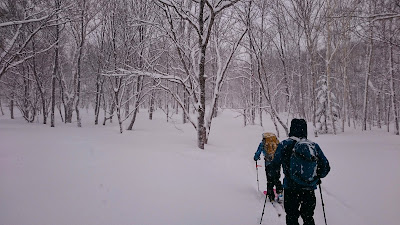 |
| Heading up on our second day. |
 |
| Yoshiko lays out the plan Behind Piano. |
 |
| The surrounding beauty helped me ignore my sore legs. |
 |
1,039 meters (3408 ft) elevation gain over 10.6 km (6.6 miles).
See GPS track. |
At night, Cameron, Becky, Peter, and I went to an excellent izakaya restaurant named Karabina (唐火七). Historically, izakayas were Japanese style pubs primarily serving drinks. Over time, they started introducing small dishes (sort of like Spanish tapas) to go with the drinks. Today, izakayas are analogous to gastropubs where you can find good food and drinks in a casual atmosphere.
 |
| The Mackerel was one of our favorite dishes at Izakaya Karabina. |
Day 3: Yōtei Volcano
Yōtei is easily the most famous peak in the Niseko area. It is dubbed the Mount Fuji of Hokkaido and it is almost mandatory for backcountry skiers visiting the area. Here's a photo I ripped off from the internet:
On a clear day without much wind, it is possible to climb to the rim, ski down the crater, and come back out all in one long day. Unfortunately, such perfect weather conditions are rare in Hokkaido and frankly I'm unsure whether we were fit enough to do it anyway (in any case, here is a
great trip report of someone that did it).
So instead we just climbed up to the tree line, which kept the snow (and us) protected from the stronger winds above. From there, we went down, up, and back down again. Peter called this strategy of skiing "yo-yoing".
 |
| The base of the volcano is flat with lots of the cute skinny trees. |
 |
| And off we go! |
 |
| Chris is happy with life. |
 |
| And so is Cameron. |
 |
| The slope gradually gets steeper the higher we go. |
 |
| Our fearless leader, Yoshiko. |
The skies didn't fully clear up on this day. On the bright side, even a few days after the storm, the snow remained light and dry. I guess that's the reward for putting up with the cold.
 |
| Becky. |
 |
| Peter. |
 |
| And Cameron splashing snow at me. |
 |
1,303 meters (4,275 ft) elevation gain over 12.5 km (7.8 miles)
See GPS track. |
Now is a good time to advertise the awesomest "power bar" you can find in any Japan convenience store: onigiri.
Onigiri (a.k.a. rice balls) are triangular snacks composed of three layers: nori sesame seed on the outside, then a layer of rice, and then a choice of fish in the center. You can find these marvelous snacks in any convenience store for less than two hundred yen (two US dollars). The main trick to remember is to keep them somewhere warm like your inner jacket pocket so that they don't turn into rice bricks. It also helps to have someone teach you how to gracefully open the plastic wrap; but when all else fails, use brute force.
 |
| Onigiri (rice balls) are the awesomest Japanese power bar for ski touring. |
Day 4: Mekunnai and Zenmekunnaidake
The original plan through the guiding company included a day of resort skiing in the Niseko area. But everyone in our group unanimously voted to do another day ski touring in peace away from the crowded resorts. As an added bonus, we got reimbursed for the price of the ski lifts.
For our last day skiing the Niseko area, we climbed two peaks: Mekunnai and Zenmekunnaidake. I know the purpose of our trip was to maximize powder, but it was still cool to bag a couple of summits. Maybe Europe is rubbing off on me.
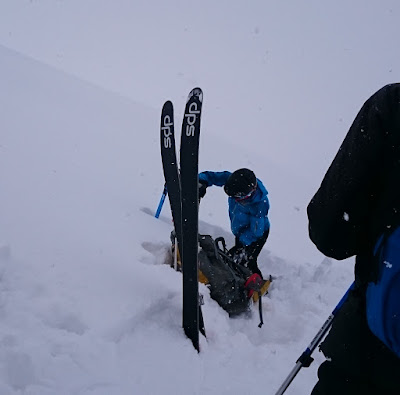 |
| Yoshiko digging a snow pit at the summit of Mekunnai. |
 |
| After getting a green light, we descended one at a time. |
 |
| See you soon, Peter! |
After Mekunnai, we also summited a nearby peak named Zenmekunnaidake. Overall, it was a long day touring for a total of eight hours. We covered a decent vertical distance, (1,260 meters) but what made it a long day was that we covered a significant horizontal distance of (16.6 km). It was a great day, and I was mentally exhausted by the end of it.
 |
1,260 meters (3,957 ft) elevation gain over 16.6 km (10.3 miles)
See GPS track. |
This was our last day in the Niseko area, which meant that we had to say goodbye to our current guide Yoshiko before meeting up with our next guide at the next place. Yoshiko was definitely one of the best guides I have known. She kindly and clearly explained everything about the weather, snow safety, terrain, and even Japanese culture. She laid amazing skin tracks that were easy to follow and preserved our energy throughout the trip. She took great care of us in a personable way that reminded me of the style of guides I have seen back in the States.
 |
| Cameron and Becky awarded Yoshiko with a t-shirt from a Wasatch mountains organization. |
For our last dinner in the Niseko area, Charles picked out a nice traditional sushi restaurant where we treated Yoshiko for dinner.
 |
| Traditional sushi restaurant where we took Yoshiko. |
 |
| We went to town on those nigiris. |
Day 5: On the road to Daisetsuzan National Park
After our four days of skiing in the Niseko area, we took a day to make our way to Daisetsuzan National Park. Our guiding company hired a van that took us there while stopping at a couple of places along the way.
My favorite stop was the Nikka whiskey distillery in Yoichi. They basically turned some old buildings of the distillery into a museum explaining its history and the process of distilling whiskey. They also provided a free tasting of their whiskey at varying ages.
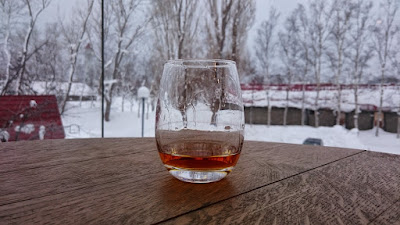 |
| Whiskey tasting at the Nikka distillery in Yoichi. |
 |
| My second favorite stop was for matcha soft serve with chocolate powder. |
We arrived in the evening at our lodging Kamihoroso in Daisetsuzan, which was fairly modest with quaint traditional rooms and tatami mats. The hotel also had a beautiful onsen (hot spring bath) overlooking the snowy mountains that we were going to climb during the following days.
 |
| Our lodging in Daisetsuzan had pretty good food despite being in the middle of the woods. |
 |
| This mystery custard had roe (fish eggs) on it. |
 |
| After dinner, Peter was ready to turn in for the day. |
 |
| So was Rug. |
Day 6: First day at Daisetsuzan National Park: Furano Dake
Next morning, we met our guide that would take care of us for the next couple of days. He is a Kiwi named Rich that spends northern hemisphere winters guiding in Hokkaido. Our arrival at Daisetsuzan was well timed with another sizable storm dumping lots of fresh snow. According to Rich, we were pretty lucky to get two good storms in less than two weeks that we were touring. Score.
For our first day skiing at Daisetsuzan, we played around Furano Dake, which is a mountain immediately south of our lodging that is popular for ski touring.
 |
| Setting up at the trailhead |
 |
| The trailhead is near a stream of water over which we must cross. |
Furano Dake's north face contains three prominent ridges over which one can ski. On our first day, we spent our time on the two ridges closest to the trailhead. I realized pretty soon that this area contained some slightly steeper terrain than back in Niseko, which was a nice change.
 |
| Here comes Peter. |
 |
| Becky too. |
Rich really worked us hard with a total of 1,545 meters of climbing and skiing in one day, which I had not done in a long time. The snow at Furano Dake was so good that it was completely worth the sweat.
 |
| We passed by some cool rock and ice formations on the way out. |
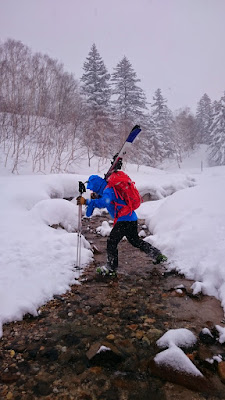 |
| Our guide Rich. |
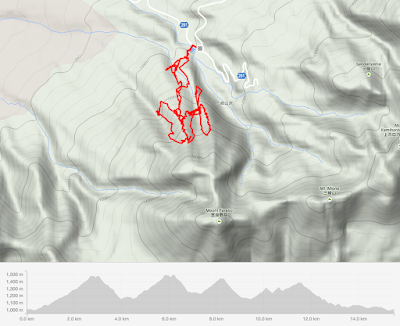 |
1,545 meters (4,938 ft) elevation gain over 15.5 km (9.6 miles)
See GPS track. |
After we got back and hung our clothes to dry, Peter and I wound down by cracking open the bottle of a 12-year old single malt whiskey that I had bought at the Nikka distillery on the previous day. It paired nicely with Peter's
Japanese shrimp flavored chips.
 |
We later got help from the rest of the group.
By the end of the night, the bottle was empty. |
Day 7: Steeper slopes of Furano Dake
On the next day, we went back to Furano Dake and spent most of our time on the third ridge that we had skipped on the previous day. With the storm now behind us, we went out to find untouched powder without the curse of poor visibility.
 |
| The beginning of the trail at the base of Furano Dake. |
 |
| We saw skinny deciduous trees naked of leaves. |
 |
| And some evergreens loaded with snow. |
I believe we skied some of the steepest slopes of our trip on this day; probably around 35 degrees. This was my favorite day because fresh powder and steeper slopes are like milk and cookies for snowboarding.
 |
| Peter ripping through the fresh powder |
Rich's style of guiding seemed akin to what I have observed back in Europe: his main job was assessing the snow, keeping us safe, and breaking trails. Once he assessed that a certain terrain was safe, he gave us a lot of freedom in choosing our lines as long as we met back at the bottom of each run.
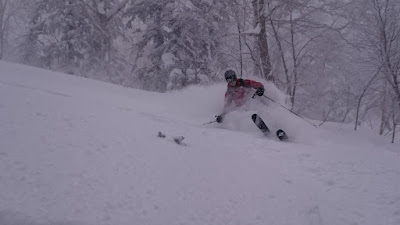 |
| Cameron spraying snow like no one's business. |
On this day, we moved a little slower and came back a little earlier probably because some people were still physically recovering from the previous long day. Maybe the whiskey had something to do with it.
 |
| Let's hit the onsen, guys! |
 |
| After face shots with almost every turn, my beard became a nest of icicles. |
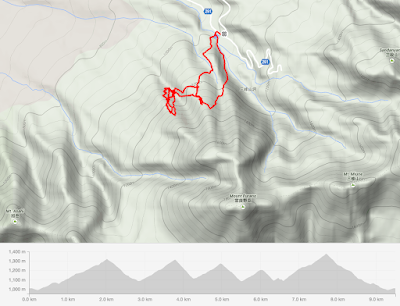 |
1,159 meters (3,803 ft) elevation gain over 9.5 km (5.9 miles)
See GPS track. |
Day 8: Last day skiing near Furano city
For our last day skiing, we had a tough decision to make: either ski the same area as the previous two days or go to a mountain closer to our final night's hotel in the city of Furano. We eventually decided to go to a new mountain near Furano to check out a new area even if it meant sacrificing a little bit of powder.
 |
| And we're off. |
Pretty early into the tour, it became obvious that this mountain had some good patches of powder as well as some more compacted snow that was beat up by the wind. Afterwards I wished that we had spent our last day back in Daisetsuzan instead, but hindsight is 20/20.
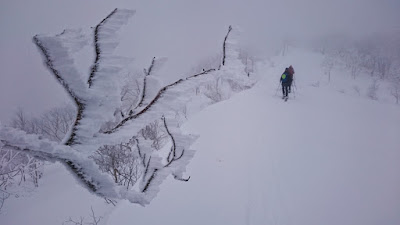 |
| The ridge was getting hammered by some serious wind. |
 |
| Becky still found some soft snow. |
 |
| So did Peter. |
 |
Here's an example of wind-affected snow.
Not nearly as fun. |
As a consolation prize, the skies cleared up and we saw some beautiful views of the surrounding mountains.
 |
| Don't forget to look around. |
When we got back to the trailhead, we already started affectionately reminiscing about our trip and the awesome time we had. Cameron and Becky presented our guide Rich with a Wasatch t-shirt too.
 |
| Man, is it really over? |
 |
1,263 meters (4,144 ft) elevation gain over 12 km (7.5 miles)
See GPS track. |
Now is a good time to advertise the best all natural "power bar" during the trip: Laure's granola bars. She makes these from scratch using all sorts of organic ingredients like honey, nuts, and dried fruits that pack a lot of energy. If you ever come ski touring with us, ask nicely and she might share some. Just like the onigiri, you should keep these warm in your pocket otherwise they will put your molars to the test. Thanks Laure for preparing all these awesome granola bars for me.
 |
| Laure's granola bar is the awesomest all natural power bar. |
Saying our goodbyes
At night, Rich invited us to his favorite restaurant in Furano city. We all fell in love with the place as soon as we walked in. It is a super casual and traditional izakaya restaurant where the chef comes around taking orders in Japanese. The food was impeccable and easily the best we had during the skiing portion of our trip.
 |
| Traditional izakaya with amazing food in Furano city. |
 |
| Peter and two kettles for boiling water over coals. |
During dinner, Peter reminded me of the last item that he needed to check off his list for this trip: karaoke. Since we first met up in Tokyo, Peter had been trying to convince me and Laure to go to a karaoke bar with him and now was our last chance. So he looked up the hottest place in town before we said our emotional goodbyes to the rest of the group.
It was awkward when we entered the karaoke bar to find no one else there other than the bartender and the owner. They even had to turn on the karaoke machine and some lights for us. But embarrassment was not enough to deter us: we sat down at the bar, ordered some drinks and started choosing our songs.
 |
| Who knew Peter had such a soft spot for romantic songs? |
Peter and I spent a few hours in that karaoke bar. I learned that Peter likes to sing sappy love songs and I like singing songs that I can scream and dance a lot. Hit the Road, Jack was my favorite. We were eventually able to find an overlap in our tastes so that we could sing a few duets. It went as well as you could possibly imagine.
 |
| I don't remember giving my camera to the bartender. |
After much effort, we eventually convinced the bartender to sing a song. As soon as she started singing her song in Japanese, Peter and I were utterly impressed at how well she sang.
 |
| We danced around with the bartender without a clue of what she was singing. |
Time to go home
On our last morning in Hokkaido, Peter and I went for a last local meal: Hokkaido style ramen. Eating ramen in Japan is a treat because each region has their own specialty depending on regional agriculture and taste. In Hokkaido, they often eat ramen with potatoes and corn grown locally with a thick slice of butter on top. This hearty style of ramen suits the the region's cold weather.
 |
| Hokkaido style ramen. |
After lunch, we headed out to the airport and reminisced about our adventure before parting ways.
Afterthoughts
Although Hokkaido admittedly does not have the most extreme terrain, steepest slopes, or even best views, its quality and quantity of snow are hard to match. The terrain is well suited for splitboarding and the guides are well experienced and versatile. In addition to the skiing itself, Hokkaido was the most culturally interesting destination for a ski trip that I have been on. I look forward to returning with Laure and our little one.





















